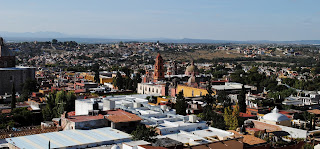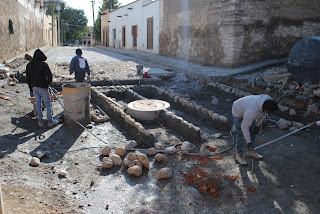For the first time in my adult life, I do not own a car. Since
the time I left home at 18, I have always had a car and it has been an integral
part of my life for the last 45 years. But owning a car in Mexico is
difficult and expensive. While San Miguel is situated at 6500 feet and nestled
in a small valley with plenty of challenging hills, our daily walking ritual has
whipped me into pretty good shape.
 |
| A roof top bar |
I love walking the quaint cobblestone
streets as we make our way about the town visiting the various mercados and
tiendas where we purchase our daily needs. In the evening we sometimes perambulate
to one of the local cantinas or roof top bars where there is plenty of cerveza
and tequila for about half the price at our old home.
In addition to walking, taxis are readily available and
remarkably cheap. Walk out on the street, and within minutes you are trundling
your way anywhere in town for 35 pesos, or about $1.85 at the current exchange
rate. The last ride we took in Oregon
was to the airport and cost $35.00! The cab drivers are generally courteous and
polite, if not frequently amused at my Spanish. Although any kind of suspension
is often long gone in these vehicles, and one can only hope that the brakes are
working when they careen down one of the steep and narrow callejons (alleys)
they use for shortcuts to avoid traffic. However, one usually arrives safely at your
destination, and hey, the price is right!
Do I miss my car? I guess so, but I certainly don’t miss the
car payment, insurance, gas, or maintenance. Those costs alone add up to more than
our rent, or provide for a very comfortable drinking budget!
Tomorrow we will walk down to get our new Mexican based cell
phone. The service includes unlimited text and calling in Mexico , the US ,
and Canada
Click any photo to open the gallery!


































